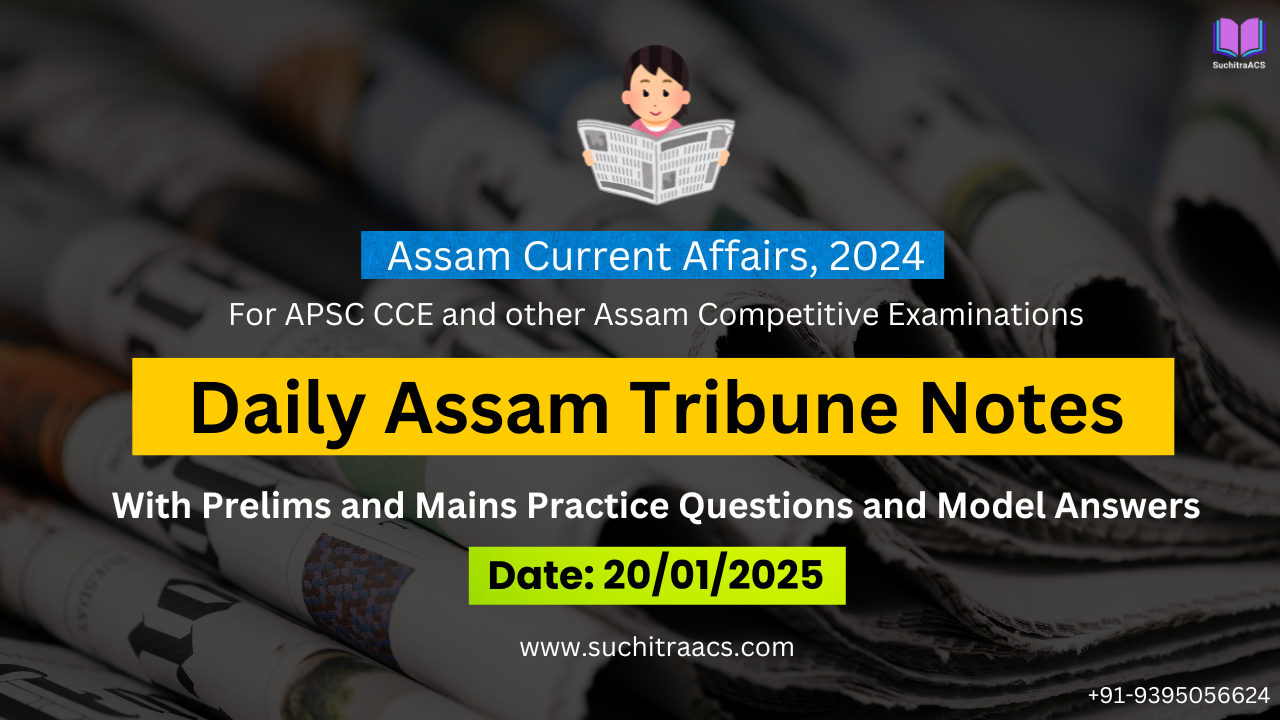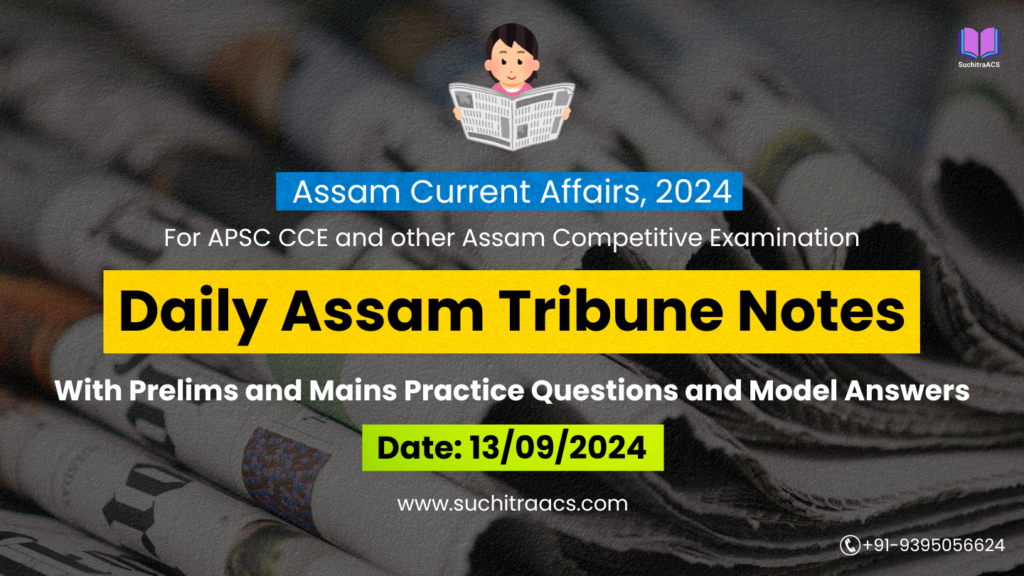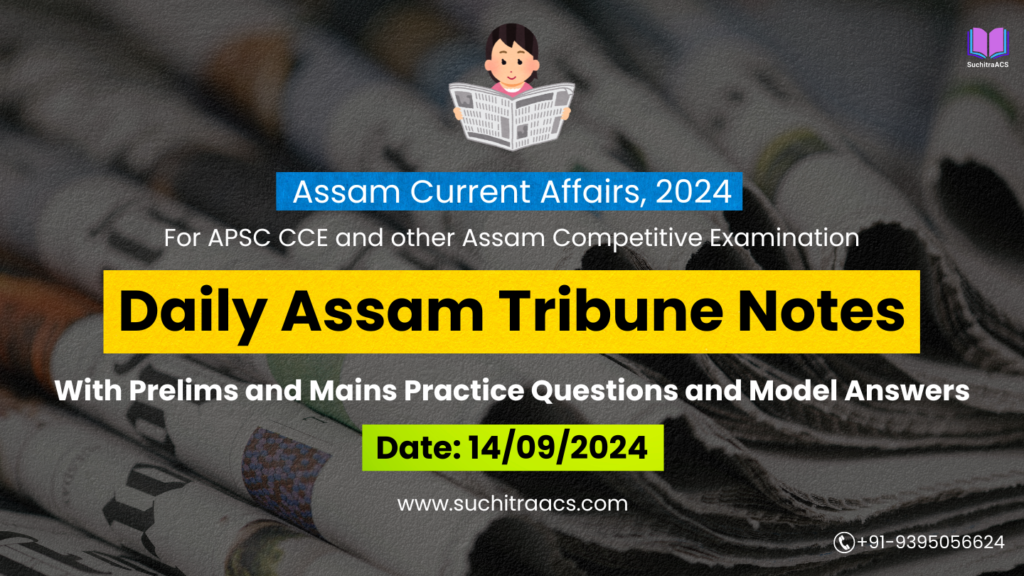APSC Current Affairs: Assam Tribune Notes with MCQs and Answer Writing (20/01/2025)
For APSC CCE and other Assam Competitive examinations aspirants, staying updated with current affairs is vital. This blog covers most important topics from the Assam Tribune today (20-01-2025). These issues are key for both APSC Prelims and Mains preparation, offering insights into the APSC CCE Syllabus.
1. Hollongapar Gibbon Wildlife Sanctuary and the Threat of Exploratory Drilling
GS Paper 3: Environment
Introduction
Hollongapar Gibbon Wildlife Sanctuary, a biodiversity hotspot in Assam, faces significant ecological threats due to the approval of exploratory oil drilling in its eco-sensitive zone (ESZ). The sanctuary is home to India’s highest primate diversity, including the endangered Western Hoolock Gibbon.
Key Points
- Biodiversity Significance:
- Hosts eight species of primates, including the critically endangered Western Hoolock Gibbon.
- Provides forest corridors linking the Dissoi Valley Reserve Forest and habitats in Nagaland.
- Threats from Exploratory Drilling:
- Risk of long-term ecological damage due to habitat destruction.
- Increased anthropogenic pressures in the eco-sensitive zone.
- Potential for future commercial exploitation following exploratory activities.
- Conservation Concerns:
- Electrification of the railway track cutting through the sanctuary exacerbates risks for arboreal species.
- Genetic isolation of gibbon families due to fragmentation of forested areas.
Prelims Pointers
- Western Hoolock Gibbon: India’s only ape species; critically endangered.
- Eco-Sensitive Zone (ESZ): Buffer areas around protected wildlife habitats where developmental activities are regulated.
- National Green Tribunal (NGT): Legal body addressing environmental issues, including ESZ violations.
Mains Pointers
Importance of Hollongapar Gibbon Wildlife Sanctuary:
- Ecological Significance:
- Biodiversity hotspot with unique flora and fauna.
- Supports ecosystem services, such as carbon sequestration and groundwater recharge.
- Cultural and Economic Value:
- Attracts eco-tourists, boosting local livelihoods.
- Holds cultural significance for indigenous communities.
Challenges:
- Developmental Pressures:
- Oil drilling and railway electrification threatening habitat integrity.
- Unchecked encroachment and deforestation.
- Policy and Implementation Gaps:
- Weak enforcement of wildlife protection and environmental regulations.
- Insufficient funding for conservation initiatives.
Government Initiatives:
- National Wildlife Action Plan (2017-2031): Focuses on strengthening wildlife corridors and mitigating human-wildlife conflict.
- Eco-Sensitive Zone Guidelines: Regulates activities around protected areas to minimize ecological disruption.
- NGT Interventions: Directions to review the environmental impacts of developmental projects in ESZs.
Way Ahead:
- Strengthening Conservation Efforts:
- Enforce strict regulations against industrial activities in ESZs.
- Implement ecological restoration measures.
- Community Engagement:
- Involve local communities in habitat protection and eco-tourism.
- Promote awareness campaigns on wildlife conservation.
- Rerouting Infrastructure Projects:
- Electrified railway tracks should be diverted outside the sanctuary.
- Conduct comprehensive Environmental Impact Assessments (EIAs) before approvals.
Conclusion
Hollongapar Gibbon Wildlife Sanctuary exemplifies Assam’s ecological heritage but faces imminent threats from developmental projects. Preserving this biodiversity treasure requires a balance between development and conservation, backed by strict regulations and community involvement.
2. Gunotsav 2025 in Assam: Ensuring Quality Education
GS Paper 2: Education, Governance
Introduction
Gunotsav 2025, a quality enhancement initiative, commenced its second phase in Assam, aiming to improve the learning outcomes of students across government and provincialized schools. This flagship program highlights the government’s commitment to strengthening the education system.
Key Points
- Scope and Implementation:
- Covers over 14 districts, including Jorhat, with participation from 1211 schools.
- Self-evaluation exercises were conducted, followed by external assessments from January 20 to 22, 2025.
- Evaluation Mechanism:
- External evaluators include senior government officials, faculty members, and district administrators.
- Focus on assessing infrastructural adequacy, teaching quality, and learning outcomes.
- Role of Samagra Shiksha Axom (SSA):
- Coordinates activities to improve the quality of education.
- Engages stakeholders in capacity building for better implementation.
Prelims Pointers
- Gunotsav Initiative: Launched by the Sarbananda Sonowal government for quality education.
- Samagra Shiksha Axom (SSA): Assam’s integrated education scheme under Samagra Shiksha Abhiyan.
- External Evaluation: A key feature ensuring transparency and accountability in assessments.
Mains Pointers
Significance of Gunotsav:
- Quality Education:
- Enhances foundational learning levels in mathematics, science, and languages.
- Promotes innovative teaching methods and capacity building.
- Infrastructure Development:
- Identifies gaps in school infrastructure and resource allocation.
- Encourages modernization of teaching aids and facilities.
- Stakeholder Engagement:
- Involves teachers, parents, and administrators in decision-making.
- Encourages community participation in school development.
Challenges:
- Teacher Shortages:
- Affects the quality of education and student-teacher interaction.
- Infrastructural Deficiencies:
- Lack of basic amenities like clean drinking water and functional toilets in rural schools.
- Assessment Accuracy:
- Ensuring unbiased and effective evaluations.
Government Initiatives:
- Samagra Shiksha Abhiyan: Integrated scheme for school education.
- RTE Act Implementation: Ensures free and compulsory education.
- Digital Education Initiatives: Introduction of smart classrooms and digital literacy programs.
Way Ahead:
- Enhanced Teacher Training:
- Regular workshops to upgrade teaching techniques.
- Community Involvement:
- Foster parental involvement in improving learning outcomes.
- Strengthening Monitoring:
- Regular audits of schools and follow-up on assessment recommendations.
Conclusion
Gunotsav 2025 reflects Assam’s commitment to fostering educational excellence. By addressing infrastructural and teaching challenges, the program can serve as a model for other states in India.
3. Role of ASEAN in Assam’s Economic Growth Under the Act East Policy
GS Paper 2: International Relations, GS Paper 3: Economy
Introduction
The Act East Policy positions Assam as a gateway to Southeast Asia, leveraging its geographical proximity to ASEAN nations. Recent trade discussions at the Indo-ASEAN summit highlighted opportunities for Assam in sectors like tea, tourism, and agro-industries.
Key Points
- Significance of ASEAN for Assam:
- Enhances trade and investment opportunities with Southeast Asia.
- Strengthens Assam’s agro-industrial exports, including tea and bamboo.
- Promotes regional connectivity via land, air, and waterways.
- Major Projects Supporting ASEAN Ties:
- Kaladan Multi-Modal Transit Transport Project: Links Assam to Myanmar for trade.
- Trilateral Highway: Connects India, Myanmar, and Thailand, boosting cross-border logistics.
- Bharatmala and National Waterways: Improves transport infrastructure to facilitate exports.
- Trade Highlights:
- Assam’s exports to ASEAN nations include tea, silk, and bamboo products.
- Discussions on ASEAN markets for Assam’s organic produce and agro-industrial goods.
Prelims Pointers
- Act East Policy: India’s initiative to strengthen ties with ASEAN nations.
- Kaladan Project: Multi-modal transit route connecting India to Myanmar.
- ASEAN Members: Includes Thailand, Vietnam, Malaysia, Myanmar, and others (10 nations).
Mains Pointers
Importance of ASEAN for Assam:
- Economic Integration:
- Enhances regional trade and reduces logistic costs.
- Opens new markets for Assam’s tea, bamboo, and handloom products.
- Strategic Importance:
- Strengthens India’s geopolitical stance in Southeast Asia.
- Acts as a counterbalance to China’s influence in the region.
- Tourism Development:
- Promotes eco-tourism and cultural exchanges with ASEAN nations.
- Attracts tourists through initiatives like Buddhist tourism circuits.
Challenges in Leveraging ASEAN Opportunities:
- Infrastructure Gaps:
- Poor road and rail connectivity hampers export potential.
- Trade Barriers:
- Non-tariff barriers and lack of standardized certifications limit market access.
- Limited Awareness:
- Lack of awareness among small businesses about ASEAN market opportunities.
Government Initiatives:
- Act East Policy: Strengthens economic and strategic ties with ASEAN nations.
- North-East Special Infrastructure Development Scheme (NESIDS): Funds projects to enhance regional connectivity.
- Border Trade Promotion: Establishes trade hubs at India-Myanmar border points.
Way Ahead:
- Boosting Infrastructure:
- Develop logistics hubs and improve border infrastructure.
- Promoting Exports:
- Provide financial incentives and certifications for Assam’s key exports.
- Strengthening Diplomatic Ties:
- Organize trade fairs and cultural exchanges to foster mutual understanding.
Conclusion
The Act East Policy offers Assam a unique opportunity to emerge as an economic bridge to ASEAN nations. By addressing infrastructural and trade-related challenges, Assam can unlock its full potential and contribute significantly to India’s regional diplomacy.
4. Bodoland Territorial Region (BTR) Development under the BTC Accord”
GS Paper 2: Polity and Governance, GS Paper 3: Regional Development
Introduction
The Bodoland Territorial Region (BTR) is witnessing a significant push toward socio-economic development following the signing of the Bodoland Territorial Council (BTC) Accord in 2020. The Assam government recently allocated ₹1,500 crore for infrastructure, education, and skill development projects in the region to enhance governance and address longstanding issues.
Key Points
- Background of the BTC Accord:
- Signed between the Government of India, Assam government, and Bodo stakeholders, including the National Democratic Front of Bodoland (NDFB).
- Aims to provide greater autonomy to the BTR while maintaining Assam’s territorial integrity.
- Key Development Initiatives:
- Infrastructure Development: Construction of roads, bridges, and educational institutions.
- Skill Development Projects: Focused on youth empowerment through vocational training.
- Healthcare Projects: Strengthening primary healthcare infrastructure.
- Political Representation:
- Enhanced political representation for Bodos in the BTC.
- Reservation of seats for Scheduled Tribes and other marginalized groups.
- Peace and Security:
- Disarmament of NDFB cadres and their reintegration into society.
- Establishment of police training institutes to enhance security.
Prelims Pointers
- Bodoland Territorial Region (BTR): Comprises four districts: Kokrajhar, Baksa, Chirang, and Udalguri.
- BTC Accord 2020: Provides administrative and financial autonomy to BTR under the Sixth Schedule.
- NDFB: Former armed group demanding a separate Bodoland, now disbanded post-accord.
Mains Pointers
Significance of BTR Development:
- Governance and Autonomy:
- Empowers local governance through BTC with administrative and financial autonomy.
- Promotes inclusive governance for tribal and non-tribal communities.
- Socio-Economic Development:
- Improves connectivity, education, and healthcare services.
- Encourages investment in the region, boosting employment opportunities.
- Peace and Reconciliation:
- Ends decades of violence and insurgency.
- Reinforces social harmony among Bodos and other ethnic groups.
Challenges:
- Implementation Issues:
- Delayed project execution due to bureaucratic hurdles.
- Ethnic Tensions:
- Conflicts between Bodos and non-Bodo communities over land and resources.
- Infrastructure Gaps:
- Insufficient access to electricity, clean water, and roads in remote areas.
Government Initiatives:
- Special Development Package: ₹1,500 crore allocated for BTR projects.
- Skill India Mission: Provides vocational training to BTR youth.
- Sixth Schedule Reforms: Ensures decentralization and local participation in governance.
Way Ahead:
- Strengthening Governance:
- Streamline administrative processes to ensure timely project delivery.
- Community Engagement:
- Foster dialogue between Bodo and non-Bodo groups to address grievances.
- Monitoring Mechanisms:
- Establish independent bodies to oversee the progress of development initiatives.
Conclusion
The BTC Accord and subsequent development initiatives represent a critical step toward peace and prosperity in the Bodoland Territorial Region. By addressing challenges and fostering inclusive development, the region can serve as a model for resolving ethnic conflicts and promoting regional growth.
APSC Prelims Practice Questions
1. Hollongapar Gibbon Wildlife Sanctuary and the Threat of Exploratory Drilling
Question 1:
Which species is considered India’s only ape?
- (a) Lion-tailed Macaque
- (b) Western Hoolock Gibbon
- (c) Assamese Macaque
- (d) Nilgiri Langur
Answer: (b) Western Hoolock Gibbon
Explanation: The Western Hoolock Gibbon is India’s only ape species and is critically endangered. Hollongapar Gibbon Wildlife Sanctuary is a key habitat for this species.
Question 2:
What is an Eco-Sensitive Zone (ESZ)?
- (a) Areas marked for heavy industrial development
- (b) Buffer zones around protected wildlife habitats regulating activities
- (c) Regions designated for unrestricted urbanization
- (d) Zones for mining and resource extraction
Answer: (b) Buffer zones around protected wildlife habitats regulating activities
Explanation: ESZs are intended to minimize ecological damage to protected areas by regulating developmental activities like mining and construction.
Question 3:
Which legal body addresses violations in Eco-Sensitive Zones (ESZs)?
- (a) Central Pollution Control Board
- (b) National Green Tribunal (NGT)
- (c) Supreme Court of India
- (d) National Biodiversity Authority
Answer: (b) National Green Tribunal (NGT)
Explanation: The NGT is responsible for handling environmental disputes, including those involving activities in ESZs.
2. Gunotsav 2025 in Assam: Ensuring Quality Education
Question 4:
What is the primary goal of the Gunotsav initiative?
- (a) Digitalizing all classrooms in Assam
- (b) Enhancing the quality of education in schools
- (c) Promoting skill development among university students
- (d) Building new schools in rural areas
Answer: (b) Enhancing the quality of education in schools
Explanation: Gunotsav focuses on assessing and improving student learning outcomes, school infrastructure, and teaching quality.
Question 5:
What role does Samagra Shiksha Axom (SSA) play in Assam’s education system?
- (a) Funds private school infrastructure
- (b) Coordinates activities to improve school education quality
- (c) Develops higher education curriculum
- (d) Provides teacher training for technical universities
Answer: (b) Coordinates activities to improve school education quality
Explanation: SSA is part of the Samagra Shiksha Abhiyan and works to enhance education quality across government and provincialized schools.
Question 6:
Which government launched the Gunotsav program in Assam?
- (a) Himanta Biswa Sarma
- (b) Tarun Gogoi
- (c) Sarbananda Sonowal
- (d) Prafulla Kumar Mahanta
Answer: (c) Sarbananda Sonowal
Explanation: The Gunotsav initiative was introduced by the Sarbananda Sonowal government to improve education standards.
3. Role of ASEAN in Assam’s Economic Growth Under the Act East Policy
Question 7:
Which of the following projects connects Assam to Southeast Asia for trade?
- Kaladan Multi-Modal Transit Transport Project
- Bharatmala Project
- Trilateral Highway
Select the correct answer using the code below:
- (a) 1 and 3 only
- (b) 2 and 3 only
- (c) 1 and 2 only
- (d) 1, 2, and 3
Answer: (a) 1 and 3 only
Explanation: The Kaladan Multi-Modal Transit Transport Project and the Trilateral Highway link Assam to Southeast Asia, facilitating trade and connectivity.
Question 8:
What is the primary objective of India’s Act East Policy?
- (a) Enhancing ties with African nations
- (b) Strengthening relations with Southeast Asia
- (c) Promoting self-reliance in defense manufacturing
- (d) Focusing on India’s western neighbors
Answer: (b) Strengthening relations with Southeast Asia
Explanation: The Act East Policy aims to enhance India’s economic, cultural, and strategic engagement with ASEAN countries and beyond.
Question 9:
Which product is a major export from Assam to ASEAN nations?
- (a) Coffee
- (b) Tea
- (c) Wheat
- (d) Spices
Answer: (b) Tea
Explanation: Assam is a leading exporter of tea to ASEAN countries, along with silk and bamboo products.
4. Bodoland Territorial Region (BTR) Development under the BTC Accord
Question 10:
Which districts form the Bodoland Territorial Region (BTR)?
- Kokrajhar
- Chirang
- Udalguri
- Darrang
Select the correct answer using the code below:
- (a) 1, 2, and 3 only
- (b) 2 and 4 only
- (c) 1, 2, 3, and 4
- (d) 1 and 3 only
Answer: (a) 1, 2, and 3 only
Explanation: The BTR comprises Kokrajhar, Chirang, Udalguri, and Baksa districts under the BTC Accord.
Question 11:
What is the main focus of the BTC Accord 2020?
- (a) Providing separate statehood for Bodos
- (b) Ensuring greater autonomy within Assam
- (c) Abolishing the Sixth Schedule provisions
- (d) Reintegrating Bodo groups into society
Answer: (b) Ensuring greater autonomy within Assam
Explanation: The BTC Accord grants administrative and financial autonomy to the BTR while maintaining Assam’s territorial integrity.
Question 12:
Which initiative is part of the BTR development plan?
- (a) Sagarmala Project
- (b) Skill India Mission
- (c) Startup India Initiative
- (d) Ayushman Bharat Yojana
Answer: (b) Skill India Mission
Explanation: The Skill India Mission is part of the development plan to empower youth in the BTR through vocational training and job opportunities.
APSC Mains Practice Question
Q. Discuss the significance of the Bodoland Territorial Region (BTR) development initiatives under the BTC Accord in promoting peace, socio-economic progress, and regional integration. Highlight the challenges faced and suggest measures to address them.”
(15 Marks, 250 Words)
Model Answer
Introduction
The Bodoland Territorial Region (BTR) was established under the BTC Accord 2020 to resolve decades-long conflict and ensure the socio-economic development of the Bodo community. It aims to provide administrative and financial autonomy while fostering regional harmony within Assam.
Body
Significance of BTR Development Initiatives
- Peace and Stability:
- Ends decades of insurgency by disarming National Democratic Front of Bodoland (NDFB) cadres.
- Reinforces trust between the government and Bodo stakeholders.
- Socio-Economic Development:
- Infrastructure projects, including roads and healthcare, enhance connectivity and quality of life.
- ₹1,500 crore allocation promotes education and skill development for regional youth.
- Cultural and Political Representation:
- Reserved seats in the Bodoland Territorial Council (BTC) ensure political empowerment.
- Protects and promotes Bodo language, art, and culture.
Challenges Faced
- Ethnic Tensions:
- Ongoing conflicts between Bodos and non-Bodo communities over land and resources.
- Implementation Bottlenecks:
- Delayed project execution due to bureaucratic hurdles.
- Infrastructure Gaps:
- Limited access to basic amenities in remote areas.
Way Forward
- Inclusive Governance:
- Foster dialogue between Bodo and non-Bodo groups for equitable resource sharing.
- Capacity Building:
- Enhance vocational training to generate employment opportunities.
- Monitoring Mechanisms:
- Establish independent bodies to track development progress and address grievances.
Conclusion
The BTC Accord and subsequent development initiatives are crucial for achieving lasting peace, socio-economic progress, and integration in the Bodoland Territorial Region. Addressing challenges through inclusive and sustainable approaches will ensure that BTR becomes a model for resolving ethnic conflicts and fostering development.
✨ APSC Prelims Crash Course, 2025
at most affordable rate in Assam!

🔔 Join Our WhatsApp Study Group!
For exclusive access to premium quality content, including study materials, current affairs, MCQs, and model answers for APSC CCE and other Assam competitive exams.
Click here to join: SuchitraACS Study WhatsApp Group
📚 Want to know more about SuchitraACS’s most affordable courses?
Click here to know more: SuchitraACS Courses for APSC CCE and Assam Competitive Examinations




